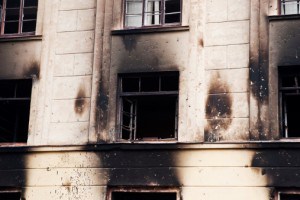Under a homeowner’s policy, there are multiple types of coverage that the policy provides. First is structure coverage; so, that is going to cover the home, for example, in a fire loss. Other structure coverage would be a detached garage that may also be damaged. There’s often debris removal coverage; coverage for trees, shrubs, etc. And then there’s . . . separate coverage for personal property.
The reason all these different types of coverage matter is that [fusion_builder_container hundred_percent=”yes” overflow=”visible”][fusion_builder_row][fusion_builder_column type=”1_1″ background_position=”left top” background_color=”” border_size=”” border_color=”” border_style=”solid” spacing=”yes” background_image=”” background_repeat=”no-repeat” padding=”” margin_top=”0px” margin_bottom=”0px” class=”” id=”” animation_type=”” animation_speed=”0.3″ animation_direction=”left” hide_on_mobile=”no” center_content=”no” min_height=”none”][there are] different limits associated with all of them. And so, it’s important that an insured [understand] “What types of coverage does my policy have,” and “What are my damages,” so that we can analyze how they match up, and what should be paid. / END TRANSCRIPT
What does a homeowner’s insurance policy usually cover?
While every homeowner insurance policy is different, most of them cover damage caused by:
- Electrical problems
- Fire
- Hail
- Theft
- Vandalism
- Water damage (in certain circumstances)
- Wind
- Plumbing problems
Catastrophic conditions, such as tornados, hurricanes and other natural disasters, are generally covered under most policies, but it is important that you review your policy carefully to ensure you have the right coverage in the event of such a disaster. If you’re not covered, you may wish to consider buying an additional policy just in case.
Generally speaking, your policy should cover structural damage (such as that discussed in the video) and property damage – both to your property (think damage to your trees or driveway) and your contents: artwork, furniture, clothing, etc. Additional Living Expense coverage should also be provided to provide for the cost of a rental home or apartment for the time your home is being repaired. This type of coverage varies, so you must make sure you have enough of it to cover you for as long as you need it, lest you end up out in the cold.
At the Gilbert Firm, we help Tennessee homeowners, business owners and non-profit organizations facing insurance disputes. To schedule a consultation with Clint Scott, or any member of our team, please call 888.996.9731, or fill out our contact form. We maintain offices in Nashville, Chattanooga, Memphis, Jackson and Knoxville.[/fusion_builder_column][/fusion_builder_row][/fusion_builder_container]
 On November 28, 2016, Gatlinburg and the surrounding areas experienced firsthand the devastation of the wildfires. The wildfires that ripped through the Smokies led to the deaths of 12 people, and injured almost 200 more. Close to 18,000 acres burned in two separate locations, and hundreds of people either lost their homes or businesses, or need to do substantial repairs and renovations.
On November 28, 2016, Gatlinburg and the surrounding areas experienced firsthand the devastation of the wildfires. The wildfires that ripped through the Smokies led to the deaths of 12 people, and injured almost 200 more. Close to 18,000 acres burned in two separate locations, and hundreds of people either lost their homes or businesses, or need to do substantial repairs and renovations. Let’s say that the worst has come to pass, and your home has sustained a significant amount of damage (as it would in a house fire). In order to make your home livable again, you need to hire a general contractor, who in turn is going to work with a plumber and an electrician in order to rebuild your home. When the bill comes due and your contractor submits it to your insurance company, the adjuster tells him or her that the company won’t pay for Overhead and Profit, or “O&P.”
Let’s say that the worst has come to pass, and your home has sustained a significant amount of damage (as it would in a house fire). In order to make your home livable again, you need to hire a general contractor, who in turn is going to work with a plumber and an electrician in order to rebuild your home. When the bill comes due and your contractor submits it to your insurance company, the adjuster tells him or her that the company won’t pay for Overhead and Profit, or “O&P.” The holiday season is upon us, which means some of you are going to have a lot of people running around your houses pretty soon. Big parties and holiday dinners are fun, but they can also lead to property damage. The most likely culprit? A house fire – but slippery walkways and anxious pets can lead to claims, too.
The holiday season is upon us, which means some of you are going to have a lot of people running around your houses pretty soon. Big parties and holiday dinners are fun, but they can also lead to property damage. The most likely culprit? A house fire – but slippery walkways and anxious pets can lead to claims, too. You purchase homeowners’ insurance in case the worst comes to pass, and your home sustains serious damage. Buried within the contract is something called the appraisal provision, or appraisal clause. The
You purchase homeowners’ insurance in case the worst comes to pass, and your home sustains serious damage. Buried within the contract is something called the appraisal provision, or appraisal clause. The  You’ve been staring at that ugly Formica countertop since you bought this house and it’s finally time to do something about it. Maybe the roof shingles are on their last legs, and it’s time to replace them once and for all. Perhaps a surprise bonus from work means the inground pool your family has dreamed about for years. Or you love your house, but a new baby on the way means it’s finally time to convert that basement into a real living area. Whatever your reasons, home renovations and upgrades can be incredibly satisfying. They can also cause issues with your insurance policy. Certain projects are more likely to affect your coverage than others, and we wanted to go through a few of them with you, in case you have a remodel in your future.
You’ve been staring at that ugly Formica countertop since you bought this house and it’s finally time to do something about it. Maybe the roof shingles are on their last legs, and it’s time to replace them once and for all. Perhaps a surprise bonus from work means the inground pool your family has dreamed about for years. Or you love your house, but a new baby on the way means it’s finally time to convert that basement into a real living area. Whatever your reasons, home renovations and upgrades can be incredibly satisfying. They can also cause issues with your insurance policy. Certain projects are more likely to affect your coverage than others, and we wanted to go through a few of them with you, in case you have a remodel in your future. Imagine for a moment that a storm touches down in Tennessee and ravages your neighborhood. You put in a claim with your insurance company for the damage you sustained, dotting every “i” and crossing every “t.” Then the insurance company sends you some mail, and instead of the check you hoped for, you see a letter telling you that your claim was denied.
Imagine for a moment that a storm touches down in Tennessee and ravages your neighborhood. You put in a claim with your insurance company for the damage you sustained, dotting every “i” and crossing every “t.” Then the insurance company sends you some mail, and instead of the check you hoped for, you see a letter telling you that your claim was denied.